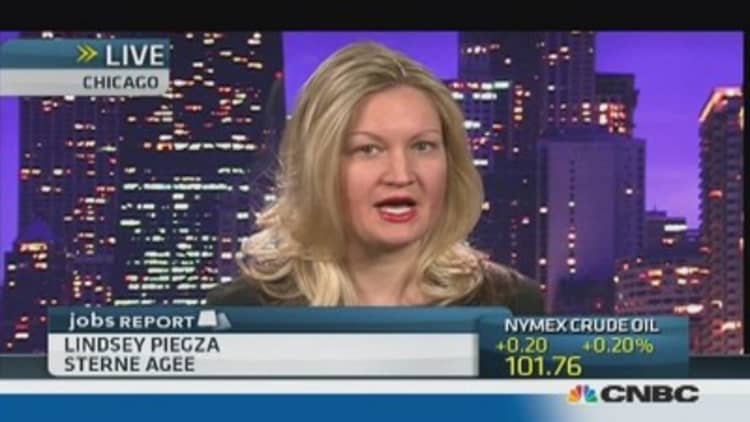The U.S. economy has been skating on an icy patch in advance of the February jobs report being released Friday.
Hiring skidded in December and January to roughly half its average monthly pace of last year. Auto buying, existing-home sales and factory orders have slid as key economic sectors surrendered to a harsh winter. And the economy entered 2014 with less momentum than initially thought.
All of which magnifies the importance of Friday's jobs report. The Labor Department data could help confirm the belief that nasty weather froze much of the job market last month—and that spring should bring a bounce back. The February jobs report could also expose some of the frailties of a still-sluggish economic recovery that's almost a half-decade old.
(Read more: Wall Street sets bar low for Friday's jobs report)
Here are five vital signs that help capture the state of the job market to date:
LAYOFFS
Evidence emerged Thursday that the economy should thaw once the weather does: 323,000 people applied for unemployment benefits last week, the Labor Department said. That might sound like a lot. But it's no more than the number who typically sought benefits before the Great Recession erupted at the end of 2007. Applications for benefits essentially reflect layoffs. And their low current levels suggest that companies foresee stronger consumer demand ahead, because layoffs would rise if employers expected business to weaken.
HIRING
It's heartening when few people are being laid off. But the other side of the equation is actual hiring. And employers haven't been filling many jobs. The nation's monthly job growth averaged a seasonally adjusted 94,000 in December and January. That was far below last year's average monthly gain of 194,000. A third straight tepid month would be deflating. For February, economists predict that 145,000 jobs were added, according to a survey by FactSet.
Still, the economy has endured cold streaks before during the recovery. It averaged fewer than 71,000 added jobs a month between December 2010 and January 2011. It averaged 99,000 for two months in mid-2012. The question is whether job growth for the rest of 2014 can elevate the pace of hiring to at least last year's average.
UNEMPLOYMENT RATE
At 6.6 percent, the rate is the lowest it's been in more than five years. That should be cause for celebration. The Federal Reserve had once said the economy might be weaned off its stimulus of near-zero short-term interest rates once unemployment fell to 6.5 percent. At that point, the gravitational pull of the recovery was supposed to be enough to propel growth. Not anymore.
What happened? The unemployment rate has become somewhat misleading. That's because lots of Americans have stopped looking for work in the past few years. Once people without a job stop looking for one, they're no longer counted as unemployed. When fewer people are counted as unemployed, the rate will fall.
(Read more: US jobless claims fall, but workers grow less productive)
Some of these people have retired. Some have abandoned a futile hunt for work. Or have returned to school. The share of people either working or looking for work dipped to 63 percent in January from 66 percent at the end of 2007, when the recession began.
Compared with before the recession, 1.35 million more people fall into a category of Americans who say they want a job but aren't actively seeking one. If you count them, the unemployment rate in January would have been 7.4 percent.
LONG-TERM UNEMPLOYED
One of the recovery's frustrating failures has been the inability of people who've been out of work for at least six months to find a job. These long-term unemployed number around 3.6 million. Their number has declined by more than 1 million over the past year, but they still account for a high 36 percent of all unemployed Americans.

The plight of many of these people has worsened. That's because unemployment benefits were cut off late last year for 1.4 million who have been out of work for six months or more. That's when an emergency federal program for the long-term unemployed expired. The National Employment Law Project estimates that an additional 600,000 long-term unemployed workers would still be receiving benefits if Congress had renewed the emergency program.
Searching for a job was one of the conditions for receiving benefits. Many economists think some portion of these people likely stopped looking for a job last month.
(Read more: Pace of job cuts eases in February: Challenger)
Most economists say the loss of those benefits could slow economic growth if many people who lost benefits haven't found a job. Without unemployment checks, those 1.4 million people have less money to spend on groceries, housing and transportation. And 70 percent of all economic activity flows from consumer spending.
EMPLOYER DEMAND
The monthly jobs report is widely followed. But many economists pay close attention to a more obscure indicator: job openings online. The private Conference Board said this week that advertised openings in February rose 268,100 to 5.19 million. This increase matters because it points to pent-up demand for workers, even if recent government data suggests otherwise.
"That speaks volumes that it's not all dire straits out there," said Jennifer Lee, senior economist at BMO Capital Markets. "That alone gives me hope that we will see stronger numbers in the next few months, if not in February itself."
—By The Associated Press

